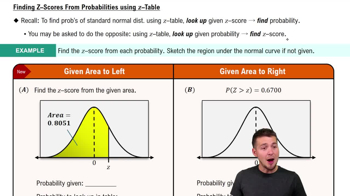Ice Cream The weights of ice cream cartons are normally distributed with a mean weight of 10 ounces and a standard deviation of 0.5 ounce.
a. What is the probability that a randomly selected carton has a weight greater than 10.21 ounces?
 Verified step by step guidance
Verified step by step guidance Verified video answer for a similar problem:
Verified video answer for a similar problem:



 9:47m
9:47mMaster Finding Standard Normal Probabilities using z-Table with a bite sized video explanation from Patrick
Start learning